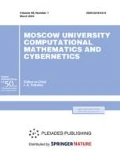Abstract
The two-species model of self-structured stationary biological communities proposed by U. Dieckmann and R. Law is considered. A way of investigating the system of integro-differential equations describing the model equilibrium is developed, nontrivial stationary points are found, and constraints on the model parameter space resulting in similar stationary points are studied. The results are applied to a number of widely known biological scenarios.
Similar content being viewed by others
References
A. G. Bodrov and A. A. Nikitin, “Qualitative and numerical analysis of an integral equation arising in a model of stationary communities,” Dokl.Math. 89, 210–213 (2014).
A. G. Bodrov and A. A. Nikitin, “Examining the biological species steady-state density equation in spaces with different dimensions,” Mosc. Univ. Comput. Math. Cybern. 39, 157–162 (2015).
M. J. Plank and R. Law, “Spatial point processes and moment dynamics in the life sciences: a parsimonious derivation and some extensions,” Bull. Math. Biol. 77, 586–613 (2015).
U. Dieckmann and R. Law, “Relaxation projections and the method of moments,” in The Geometry of Ecological Interactions: Simplifying Spatial Complexity (Cambridge Univ. Press, Cambridge, 2000), pp. 252–270.
U. Dieckmann and R. Law, “Relaxation projections and the method of moments,” in The Geometry of Ecological Interactions: Simplifying Spatial Complexity (Cambridge Univ. Press, Cambridge, 2000), pp. 412–455.
R. Law, D. J. Murrell, and U. Dieckmann, “Population growth in space and time: spatial logistic equations,” Ecology 84, 252–262 (2003).
D. J. Murrell and U. Dieckmann, “On moment closures for population dynamics in continuous space,” J. Theor. Biol. 229, 421–432 (2004).
V. I. Danchenko, A. A. Davydov, and A. A. Nikitin, “On integral equation for stationary distribution of biological communities,” in Problems of Dynamical Equation (Mosk. Gos. Univ., Moscow, 2009), No. 3, pp. 15–29 [in Russian].
A. A. Davydov, V. I. Danchenko, and M. Yu. Zvyagin, “Existence and uniqueness of stationary distribution of the biological community,” Tr.MIAN 267, 46–55 (2009).
N. Baddour, “Operational and convolution properties of two-dimensional Fourier transforms in polar coordinates,” J. Opt. Soc. Am. 26, 1767–1777 (2009).
J. Murrell and R. Law, “Heteromyopia and the spatial coexistence of similar competitors,” Ecol. Lett. 6, 48–59 (2003).
Author information
Authors and Affiliations
Corresponding author
Additional information
Original Russian Text © A.A. Nikitin, A.S. Savost’yanov, 2017, published in Vestnik Moskovskogo Universiteta, Seriya 15: Vychislitel’naya Matematika i Kibernetika, 2017, No. 3, pp. 18–25.
The results in Sections 2, 4, 6 were obtained by A.A. Nikitin supported by the Russian Science Foundation, project no. 17–11–01168.
About this article
Cite this article
Nikitin, A.A., Savost’yanov, A.S. Nontrivial stationary points of two-species self-structured communities. MoscowUniv.Comput.Math.Cybern. 41, 122–129 (2017). https://doi.org/10.3103/S0278641917030050
Received:
Published:
Issue Date:
DOI: https://doi.org/10.3103/S0278641917030050




